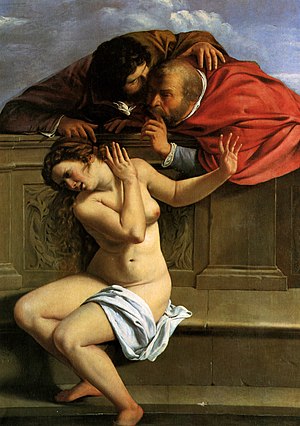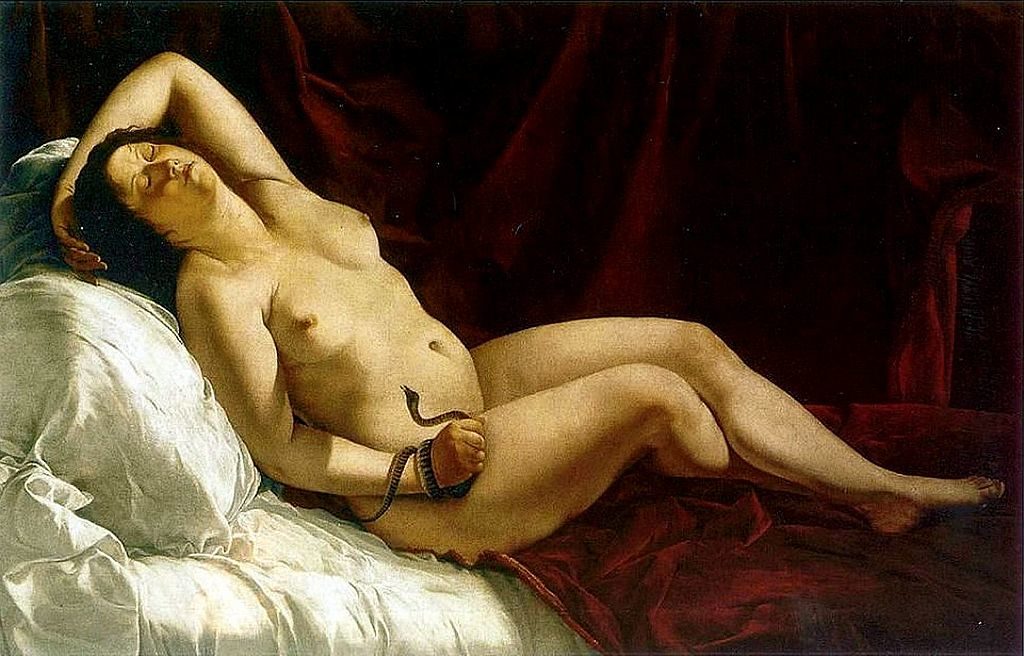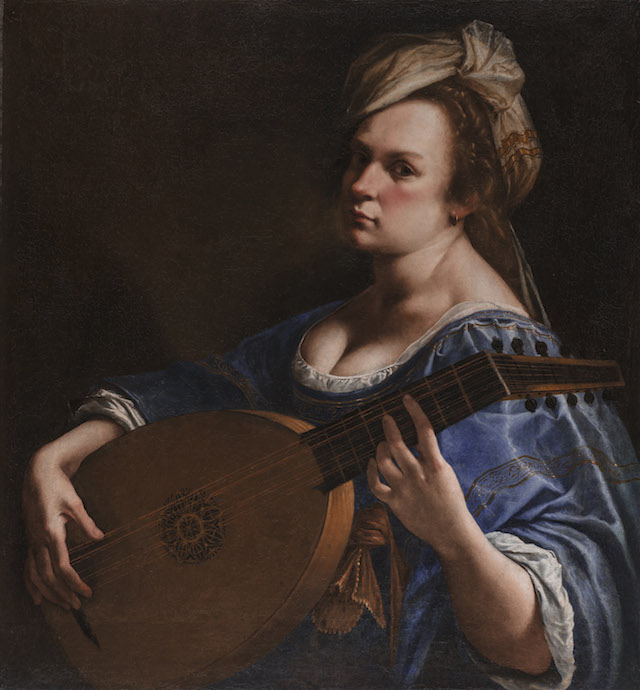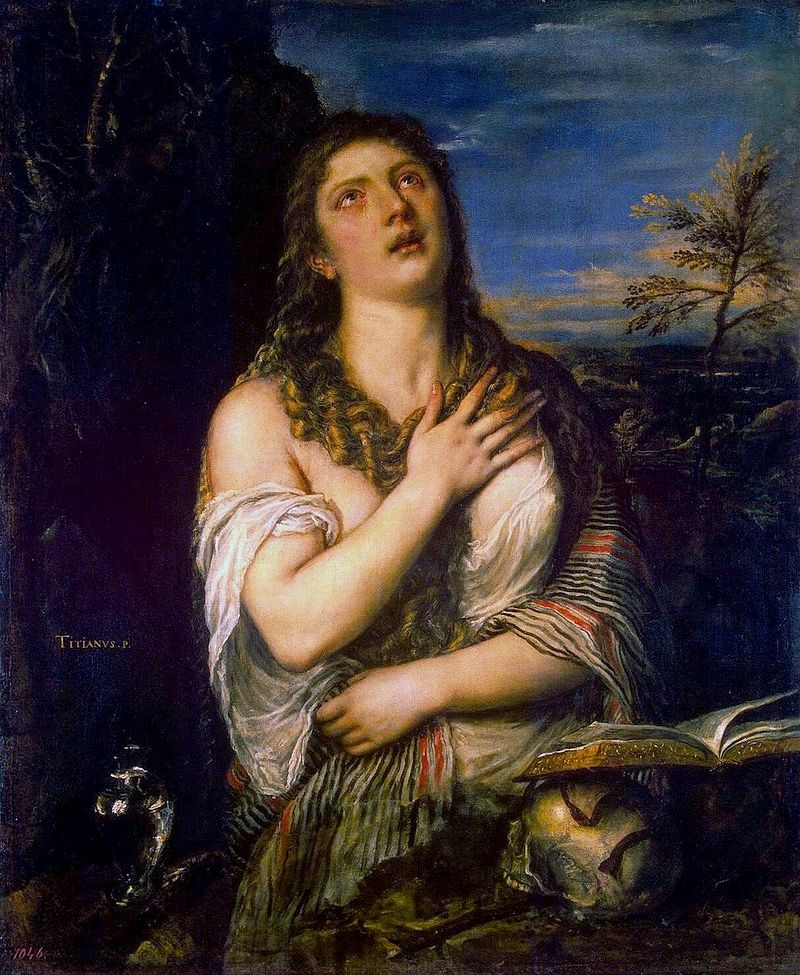A Curator’s Perspective
Guest post by Judith W. Mann, Curator of European Art to 1800, the Saint Louis Art Museum
On the occasion of what would have been Artemisia Gentileschi’s 426th birthday (July 8), it is worth reflecting on events of the last year that mark important milestones in the perception of this most important painter.
In July 2018, the National Gallery London formally announced its purchase of a fascinating picture that Artemisia made during her years in Florence (roughly 1612–1620), a Self-Portrait as Saint Catherine of Alexandria (fig. 1). One of the finest and most prominent collections of Italian baroque painting had finally obtained an example of a major figure in seventeenth-century art as well as one of the most recognized women artists in the history of art. Perhaps even more important, it had paid £3.6 million ($4.7 million), a sum more than three times the record previously set for an Artemisia at auction in the summer of 2014. That painting, the Mary Magdalene in Ecstasy (discussed below, see fig. 8), marked the first time more than $1 million had been spent on any work by Artemisia’s hand.

Self-Portrait as Saint Catherine of Alexandria, 1615–17,
oil on canvas. National Gallery, London.
Art celebrity and market value: what is the connection?
To those unfamiliar with the workings of the art world, such a sum may seem de rigueur in a market where inexplicably large sums of money have been paid with increasing frequency. But in truth, although paintings created by male artists have routinely fetched multi-million-dollar prices for decades, the products of women artists’ labors have not realized such high prices. Artemisia Gentileschi enjoys widespread fame among art historians, museum curators, and college students. Art history surveys have, for several decades, made her a fixture in the teaching of baroque art. In 2001, when the Metropolitan Museum of Art showed the exhibition “Orazio and Artemisia Gentileschi: Father and Daughter Painters in Baroque Italy,” (a show for which I was the originating curator), visitors to the exhibition were asked which of the two painters they liked best. The response was almost three to one in favor of Artemisia. Yet, at that time the largest sum that had been paid for an Artemisia on the market had been less than $500,000 while one of her father’s paintings was offered for sale by a New York dealer with a price of $6,000,000. There was (and still is) a clear disconnect between Artemisia’s celebrity and the market value of her paintings.
One is tempted to explain this phenomenon by saying that Artemisia’s fame exists within a small segment of the public, making it unsurprising that her pictures are not highly valued in the art market. However, the “small segment” that encompasses Artemisia’s fans also includes dealers and auction houses. Furthermore, her father is also appreciated by only a “small segment,” and yet his prices continue to rise. In January 2016 the Getty secured a work by Orazio for over $34 million, only two years after an Artemisia picture finally surpassed the $1 million mark. It is hard to understand why it has taken such a long time for his daughter to fetch multi-million dollar prices, and harder still to fathom why her prices still lag far below those of less important male artists. I can offer no definitive explanation for this, other than to note that when it comes to women artists, the market is distressingly conservative and slow to match the prices paid at auction for art created by male artists. Nonetheless, the amount paid for the newest Artemisia is still something of a marker and we should savor the moment.
Artemisia’s early master works
Rather than puzzling over the art market, it is more worthwhile to enjoy these two marvelous paintings that have set record prices. When institutions set their sights on getting a work created by an artist with a famous name, there is often a temptation to settle for something of lesser quality. The National Gallery did not, in my estimation, do that. Rather, they pursued an outstanding example of Artemisia’s work, created during the very productive period that she spent in Florence.

Artemisia moved from Rome to Florence in 1612 or 1613, having married a minor Florentine artist in the aftermath of her rape and the subsequent trial of her assailant, Agostino Tassi. When the assault occurred in March of 1611, Artemisia had already created one of the masterpieces of the early baroque, her signed and dated (1610) rendition of Susanna and the Elders (fig. 2). During the period of the legal proceedings, she created two more early masterworks, the powerful Cleopatra (fig. 3) in a private Milanese collection and the subsequent reworking of the reclining nude figure in her Danaë (fig. 4) in the Saint Louis Art Museum.

The Danaë, a forthrightly erotic painting, exhibits a daring approach to imagery. It shows the heroine who had been locked away by her father because he feared that if she became pregnant, an oracle’s prophesy would be realized and the resulting offspring would kill her father. The god Zeus was able to find her nonetheless. Transforming himself into golden rain, he entered the locked chamber and impregnated her. Few artists had addressed the nature of their coupling so directly; the gold coins pile up on Danaë’s pubic area. Some seem to have been forcefully pushed between her fingers, a fitting and obvious visual metaphor. Crafted by a female hand, such a sensuous picture must have provided additional pleasure to its original owner, very probably a male patron.

Saint Louis Art Museum, Missouri.
Original renditions of Saint Catherine
The newly discovered Artemisia (fig.1) displays a similar ability to infuse her art with fresh originality. In this case, the artist repeated a composition that she had already done, Saint Catherine (fig. 5). That work depicted the popular early Christian martyr Catherine of Alexandria, a princess whose oratorical victory over the Roman emperor in support of her Christian belief resulted in torture and eventual beheading. Artemisia’s initial rendering showed the saint in a sumptuous crown and costume, holding a martyr’s palm and fingering the spikes of the wheel used to inflict her suffering. She gazes heavenward to suggest the source of her faith.

Galleria degli Uffizi, Florence.
In refashioning the composition in the National Gallery picture, Artemisia modified the pose, repeating one that she developed for a self-portrait. In that picture, Self-Portrait as a Lute Player (fig. 6), she depicted herself gazing steadfastly at the viewer while strumming a lute. Her hair has been curled and she wears earrings and a turban. I have suggested she may have been presenting herself as a courtesan. Even if we can’t confirm that she intended such a brazen act, it is certainly a work in which she took on a persona other than that of an artist.

In the new painting (fig. 1), Artemisia adopted the pose and gaze of the Self-Portrait and then added the trappings of the Saint Catherine. She supplemented them with a halo and loosened the turban so it drapes over the crown. One can only take it to be a self-conscious presentation of artifice and role-playing. Using her own countenance, she has suggested three different aspects of the image, princess (the crown), saint (the halo) and artist (the studio prop sash). We are to understand this perhaps as a commentary on the artist as creator and role player, making it a novel presentation by a creative practitioner.
A new take on Mary Magdalene
The Mary Magdalene in Ecstasy is similarly inventive. Artemisia offered a new interpretation of a popular subject. For a large portion of seventeenth-century artists and viewers, Mary represented a repenting sinner who became a devoted follower of Jesus. Her experience is often portrayed as a dramatic rejection of an errant past and the embrace of a pious future. These themes were most expediently depicted through a flood of heavenly light falling over the penitent saint. Seventeenth-century artists typically portrayed Mary’s chest, face, arms, torso, and hair radiant with glowing coloration. Titian produced some of the most eloquent renditions of the type, where the strands of the saint’s golden hair and the threads of her clothing enhance the sense of a luminous divine presence (fig. 7).

Hermitage Museum, Saint Petersburg.
Presented as a half-figure with a sensuous body and luxuriant hair, Mary usually clasped her hands in prayer or touched a symbol (most often a skull or a book). These tangible elements evidence both the physical world of sin (Adam’s skull) as well as the promise of an eternal life through meditation and prayer (the book).
What is unusual in Artemisia’s Mary Magdalene painting (fig. 8) is the presentation of a figure in full command, luxuriating in deep personal satisfaction. The source of her pleasure is not made clear, although one can speculate. She contemplates no specific object—neither a skull, nor a crucifix, nor a text. Her ointment bottle, a traditional attribute, is not depicted, and she does not direct her gaze at some unseen heavenly force. There are no signs of emotional turmoil. Her clasped hands express neither prayer nor earthly renunciation; she merely embraces her knees as she pulls them toward her torso. Presumably, she is bathed in the light of spiritual enlightenment; Artemisia has presented her in her post-conversion state, completely at peace with her newfound path. This is an entirely original interpretation, and one that bespeaks an artist of exceptional narrative talent.

Private Collection.
Market values for Artemisia Gentileschi paintings do not tell the full story. The new work that has recently been added to her oeuvre buttresses our sense of her as a daring and original artist, valuable no matter how high (or low) the price.
Dr. Judith W. Mann is Curator of European Art to 1800 at the Saint Louis Art Museum. She was the originating curator for the 2001–2002 exhibition “Orazio and Artemisia Gentileschi: Father and Daughter Painters of Baroque Italy,” and oversaw the portion of the catalogue devoted to Artemisia. She was one of the curators for the 2016–17 show, “Artemisia e il Suo Tempo” at the Palazzo Braschi, Rome. In 2005, she edited and contributed to Artemisia Gentileschi: Taking Stock, and she continues to publish on the artist. In 2018, she acquired a portrait by Angelica Kauffmann, Woman in Turkish Dress, for the Saint Louis Art Museum.
Interested in learning more about Artemisia? Visit the Art Herstory Artemisia Gentileschi resource page!
More Art Herstory blog posts about Artemisia:
Exhibiting Artemisia Gentileschi; From the Connoisseur’s Collection to the Global Museum Blockbuster, by Christopher R. Marshall
Judith’s Challenge, from Lavinia Fontana to Artemisia Gentileschi, by Alessandra Masu
Thoughts on Feminist Art History in the Wake of Artemisia: Vrouw & Macht at Rijksmuseum Twenthe, by Dr. Jitske Jasperse
Artemisia Gentileschi: What Wasn’t in the London Exhibition and Why it Matters, by Jesse Locker
“Artemisia” at the National Gallery: A Review, by Sheila McTighe
Two of a Kind: Giovanna Garzoni and Artemisia Gentileschi (Guest post by Mary D. Garrard)
Portrayals of Mary Magdalene by Early Modern Women Artists, by Diane Apostolos-Cappadona
More Art Herstory blog posts about Italian women artists:
Plautilla Bricci: A Painter & “Architettrice” in Seventeenth-century Rome, by Alessandra Masu
The Restoration of Royalty: Lavinia Fontana’s Queen of Sheba and King Solomon, by Aoife Brady
By Her Hand: Personal Thoughts and Reflections on an Exhibition, by Oliver Tostmann
Sister Eufrasia Burlamacchi (Lucca, 1478–1548), by Loretta Vandi
Elisabetta Sirani of Bologna (1638–1665), by Adelina Modesti
“I feel again the violence of a curious desire”: Rare client testimonies on Rosalba Carriera’s erotic art, Guest post by Angela Oberer
Lavinia Fontana: Italy’s First Female Professional Artist, by Elizabeth Lev
Plautilla Bricci (1616–1705): A Talented Woman Architect in Baroque Rome, by Consuelo Lollobrigida
Sister Caterina Vigri (St. Catherine of Bologna) and “Drawing for Devotion”, by Kathleen G. Arthur)
Orsola Maddalena Caccia (1596-1676), Convent Artist, by Angela Ghirardi
Rediscovering the Once-Visible: 18th-century Florentine Artist Violante Ferroni, by Ann Golob
A Tale of Two Women Painters (Guest post / exhibition review by Natasha Moura
The Protofeminist Insects of Giovanna Garzoni and Maria Sibylla Merian, by Emma Steinkraus
Renaissance Women Painting Themselves, by Katherine A. McIver
Other Art Herstory blog posts you might enjoy:
Portrayals of Mary Magdalene by Early Modern Women Artists, by Diane Apostolos-Cappadona
Thoughts on By Her Hand, the Hartford Iteration, by Erika Gaffney
Do We Have Any Great Women Artists Yet? (Guest post by Sheila ffolliott)
The Politics of Exhibiting Female Old Masters (Guest post by Sheila Barker)
Susanna Horenbout, Artist & Courtier (Guest post by Kathleen E. Kennedy)
Angelica Kauffman and Mary Moser: Founding Women Artists of the Royal Academy
Gesina ter Borch: Artist, not Amateur (Guest post by Nicole E. Cook)
Hearts of Our People: Native Women Artists (Guest post by Elizabeth Sutton)
‘Bright Souls’: A London Exhibition Celebrating Mary Beale, Joan Carlile, and Anne Killigrew (Guest post by Laura Gowing)
New Adventures in Teaching Art Herstory (Guest post by Julia Dabbs)
Rachel Ruysch (1664–1750): A Birthday Post
A Dozen Great Women Artists, Renaissance and Baroque
Why Do Old Mistresses Matter Today? (Guest post by Merry Wiesner-Hanks)





I’m so glad I took the time to read this thoughtful and beautifully illustrated essay. I’d never seen either the Saint Catherine or the Mary Magdalene and was moved by both the images and the insightful commentary. Thanks.
We are indebted to Judith W. Mann, St Louis Art Museum, for an informed, lavishly illustrated piece on Artemisia Gentileschi. This is an important figure who only lately is receiving a measure of respect in the art market and among art historians. Though always valued by feminist scholars, she has been rather sidelined over the centuries, perhaps owing to her contemporary reputation as a somewhat unsavory figure (and I have yet to find enough information on her sexual assault, and her reputation at the Stuart court); likewise, the explicit and overt sexuality of her many genre paintings was highly unusual for a woman painter of her era. (Place her alongside, say, Mary Beale or Anne Killigrew, you’ll see what I mean.) As a rare book collector, my special interest in this essay is its intelligent, fresh emphasis on recent appreciating valuations of Gentileschi’s paintings in the commercial art market. Scholars need to pay more attention to this dimension. And special thanks to Erika Gaffney for initiating this useful ArtHerstory blog. Brava, Erika! Give us more. //
Hi, I’m doing a research and it has occurred to me that you didn’t quote Caravaggio’s influence on Artemisia Gentileschi’s Mary Magdalene in Ecstasy. The composition is heavily influenced by his take on the saint’s beatitude moment. Artemisia made it her own, but it’s worth to mention Caravaggio’s contribution in my opinion.